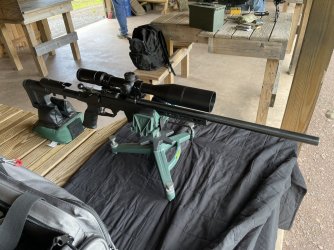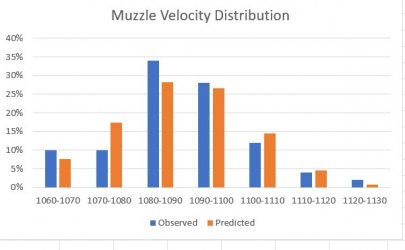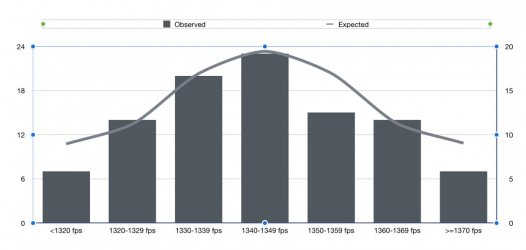Kent Goldings
.357 mag
I was watching a Youtube video where the OP was doing some load testing. He fired several 5-round groups while measuring the muzzle velocity, computed the mean and standard deviation of that random variable.
He presented the results proudly and was moving to make a conclusion about each different loading. That's when I began to question his method.
My thinking was that the margin-of-error on the standard deviation of the muzzle velocity gathered from only 5 rounds was too large to make such judgements.
In order to support my think, I did some load testing of my own. Using CCI Standard velocity 22 LR, I chronographed an entire 50-round box.



I compared the distribution of the observed velocities with what would be expected, if the muzzle velocities obeyed a normal distribution.

After performing a "goodness-of-fit" statistical comparison of the two distributions, I found that the two did not differ in a statistically significant way. That is, the observed distribution supports the claim that muzzle velocities are distributed normally.
If this is the case, a sample size of 5 does not provide conclusive information on the standard deviation of the muzzle velocity.
For example, the standard deviation of the 50 shots above was 13.1 fps.
If that computation had been done after only five rounds, the 95%-confidence interval that estimates the standard deviation of the entire box ranges from 8 to 40 fps. That is, the standard deviation of the box could be as high as 40 fps.
He presented the results proudly and was moving to make a conclusion about each different loading. That's when I began to question his method.
My thinking was that the margin-of-error on the standard deviation of the muzzle velocity gathered from only 5 rounds was too large to make such judgements.
In order to support my think, I did some load testing of my own. Using CCI Standard velocity 22 LR, I chronographed an entire 50-round box.



I compared the distribution of the observed velocities with what would be expected, if the muzzle velocities obeyed a normal distribution.

After performing a "goodness-of-fit" statistical comparison of the two distributions, I found that the two did not differ in a statistically significant way. That is, the observed distribution supports the claim that muzzle velocities are distributed normally.
If this is the case, a sample size of 5 does not provide conclusive information on the standard deviation of the muzzle velocity.
For example, the standard deviation of the 50 shots above was 13.1 fps.
If that computation had been done after only five rounds, the 95%-confidence interval that estimates the standard deviation of the entire box ranges from 8 to 40 fps. That is, the standard deviation of the box could be as high as 40 fps.




